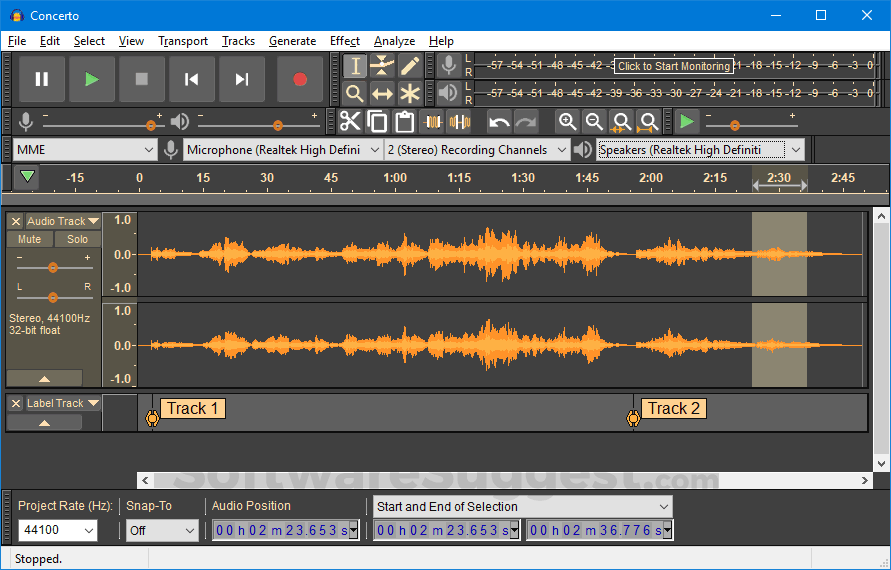

- #Audacity app software#
- #Audacity app code#
- #Audacity app license#
- #Audacity app download#
- #Audacity app free#
Vocal Reduction and Isolation for creation of karaoke tracks and isolated vocal tracks.Noise Reduction based on sampling the noise to be minimized.Large array of digital effects and plug-ins.Precise adjustments to speed ( tempo) while maintaining pitch, to synchronize audio with video or for precise running time.You can help by converting this section, if appropriate. This section is in list format but may read better as prose. Īudacity is somewhat customizable and supports arbitrary arrangements of its toolbars, custom themes and enabling and disabling of several features. It additionally features a console for Nyquist, a Lisp dialect, in which users can script their own plugins and support for external python scripting. Customizability and extensibility Īudacity supports LADSPA, LV2, VST, VST3, Audio Units, Vamp and Nyquist plugins, which allows it to load most audio effect plugins. In conjunction with batch processing features, Audacity can be used to convert files from one format to another, or to digitize records, tapes or MiniDiscs. Due to patent licensing concerns, the FFmpeg library necessary to import and export proprietary formats such as M4A (AAC) and WMA is not bundled with Audacity but has to be downloaded separately. Importing, exporting and conversions Īudacity natively imports and exports WAV, AIFF, MP3, Ogg Vorbis, and all file formats supported by libsndfile library. For a long time, non-destructive editing was exclusive to volume envelopes and playback rates, but since version 3, this has been extended to clip trimming and effects. This comes with certain benefits but means that any change made cannot be tweaked later on without undoing all changes in-between. Historically, Audacity is a destructive editor, meaning all changes are directly applied to the waveform. In addition to a normal mode, recordings can be scheduled ("Timer Record"), or used in a Punch in and roll fashion. It is currently used in the Sound Creation unit of the UK OCR National Level 2 ICT course.Īudacity can record multiple tracks at once, provided the sound card supports it. It has been used to record and mix entire albums, such as by Tune-Yards. In addition to recording audio from multiple sources, Audacity can be used for post-processing of all types of audio, including effects such as normalization, trimming, and fading in and out.
#Audacity app free#
In April 2021, it was announced that Muse Group (owners of MuseScore and Ultimate Guitar) would acquire the Audacity trademark and continue to develop the application, which remains free and open source. Most of its changes were eventually incorporated into the mainline version and the fork ended. Over the years, additional volunteer contributors emerged, including James Crook who started the fork DarkAudacity to experiment with a new look and other UX changes.
#Audacity app software#
Mazzoni eventually left CMU to pursue software development and in particular development of Audacity, with Dannenberg remaining at CMU and continuing development of Nyquist, a scripting language which Audacity uses for some effects. On May 28, 2000, Audacity was released as Audacity 0.8 to the public. The project was started in the fall of 1999 by Dominic Mazzoni and Roger Dannenberg at Carnegie Mellon University, initially under the name CMU Visual Audio.
#Audacity app license#
Executables with VST3 support are licensed GPL-3-only to maintain license compatibility.
#Audacity app code#
It was previously served from Google Code and SourceForge, where it was downloaded over 200 million times.
#Audacity app download#
Īs of December 6, 2022, Audacity is the most popular download at FossHub, with over 114.2 million downloads since March 2015. GPL v2 or Later, CC-BY-3.0 (documentation) Īudacity is a free and open-source digital audio editor and recording application software, available for Windows, macOS, Linux, and other Unix-like operating systems. Afrikaans, Arabic, Basque, Bulgarian, Catalan, Chinese (simplified), Chinese (traditional), Corsican, Czech, Danish, Dutch, English, Finnish, French, Galician, German, Greek, Hungarian, Irish, Italian, Japanese, Lithuanian, Macedonian, Marathi, Norwegian ( Bokmål), Polish, Portuguese, Romanian, Russian, Slovak, Slovenian, Swedish, Turkish, Ukrainian, Vietnamese and Welsh.


 0 kommentar(er)
0 kommentar(er)
